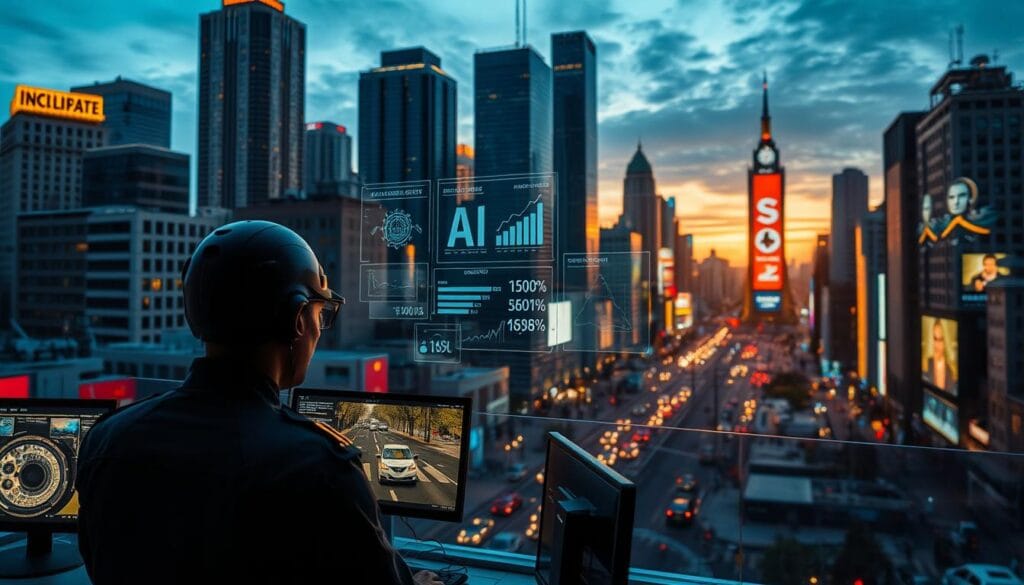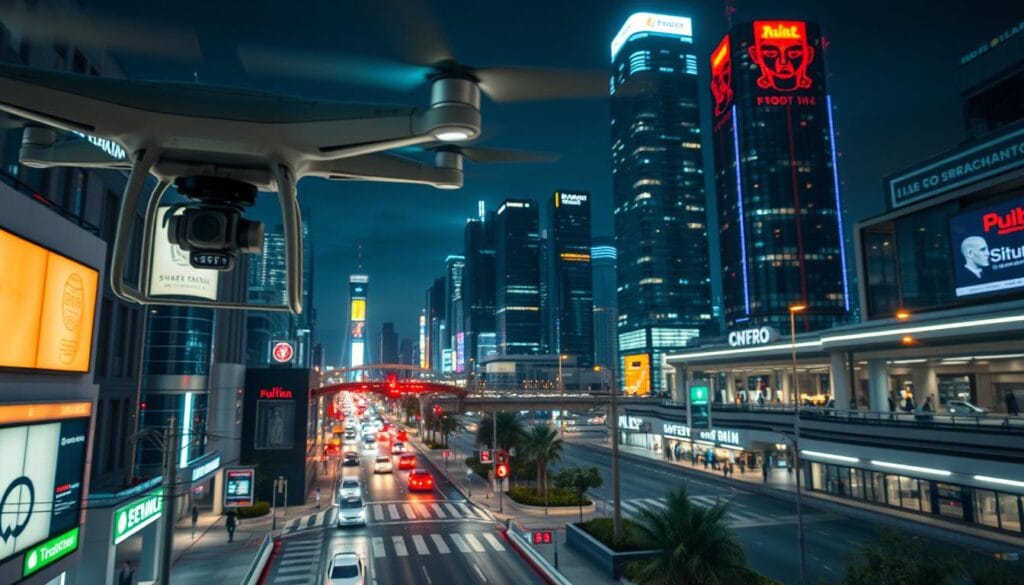“Technology is nothing. What’s important is that you have faith in people, that they’re basically good and smart, and if you give them tools, they’ll do wonderful things with them.” – Steve Jobs. This sentiment rings true as advanced tools reshape law enforcement and public safety. Modern challenges demand innovative solutions, and AI agents are stepping up to the plate.
Federal agencies generate vast amounts of data daily, necessitating advanced algorithms for processing and analysis1. AI solutions automate back-office tasks, saving hundreds of man-hours2. This efficiency allows officers to focus on critical tasks, enhancing overall operational effectiveness.
Real-time analytics enable faster, more accurate investigations. Tools like Veritone Illuminate reduce the time needed to analyze unstructured data significantly2. Such advancements are crucial in today’s fast-paced environment, where every second counts.
Despite these benefits, challenges remain. Resource constraints and increasing data loads strain traditional methods. However, AI-infused tools optimize workflows, reallocating human hours to more critical tasks2. This balance is essential for maintaining public trust and safety.
Key Takeaways
- AI agents transform data processing in law enforcement.
- Real-time analytics speed up investigations.
- Automation reduces manual workload significantly.
- Resource constraints are mitigated by AI tools.
- Public trust is maintained through efficient operations.
Introduction to AI in Public Safety

Modern law enforcement faces growing challenges, requiring smarter tools to stay ahead. AI-driven solutions are transforming how agencies handle public safety, offering new ways to manage data and improve efficiency. From surveillance to predictive analytics, these technologies are reshaping the landscape of crime prevention and response.
Emerging Technologies and Their Impact
Advancements in AI have led to significant improvements in surveillance and video analysis. Tools like C3 AI Law Enforcement have reduced the time needed to access crime statistics from days to instant availability3. This shift allows agencies to respond faster and more effectively to threats.
AI also plays a crucial role in data transcription and analysis. By linking hundreds of thousands of records across disparate sources, these tools provide a comprehensive view of criminal activity3. This capability enhances decision-making and resource allocation.
Overview of AI Adoption in Law Enforcement
Many law enforcement agencies are integrating AI to manage overwhelming data loads. Predictive policing systems, for example, forecast when and where crimes are likely to occur, aiding in monitoring and arrests4. These systems help agencies allocate resources more strategically.
However, the adoption of AI is not without challenges. Concerns about bias and transparency in algorithms remain significant. Addressing these issues is crucial to maintaining public trust and ensuring fair outcomes4.
Despite these challenges, the benefits of AI in law enforcement are clear. By automating manual tasks and providing actionable insights, these tools enhance operational efficiency and public safety5. Learn more about AI in business to see how similar technologies are applied across industries.
Technology Advancements Transforming Public Safety

Cutting-edge technology is reshaping how public safety operations function. By leveraging advanced analytics and machine learning, agencies can process data faster and make smarter decisions. These innovations are not just improving efficiency but also enhancing accuracy in critical situations.
Advanced Analytics and Real-Time Data Processing
Real-time data processing is a game-changer for public safety. Tools powered by advanced analytics can analyze vast amounts of information instantly. For example, AI-driven platforms fuse structured and unstructured data to support investigations, reducing response times by up to 30%6.
These systems also predict crime hotspots with 70% accuracy, allowing agencies to allocate resources more effectively6. This proactive approach helps prevent incidents before they escalate, ensuring safer communities.
Integration of Machine Learning and Decision Intelligence
Machine learning models are transforming decision-making in public safety. By analyzing historical data, these models provide actionable insights that streamline operations. For instance, AI-driven traffic management systems have reduced accidents by 25% through real-time analysis6.
Decision intelligence tools also enhance situational awareness. Video analytics technology, for example, improves identification capabilities and provides real-time insights, making operations more efficient7. These advancements are redefining traditional safety strategies, making them smarter and more effective.
The Role of AI Agents in Enhancing Public Safety and Law Enforcement

The integration of artificial intelligence into law enforcement is revolutionizing the way officers process information and respond to incidents. From automating surveillance to streamlining data management, these tools are transforming daily operations. Police departments are leveraging advanced systems to enhance their ability to analyze and act on critical information quickly.
Automated Surveillance and Link Analysis
Automated surveillance systems are now a vital part of modern policing. These tools use machine learning to monitor public spaces, identifying potential threats in real-time. For example, automated facial recognition and ALPR systems have significantly improved the speed and accuracy of identifying suspects8.
Link analysis is another powerful application. By connecting disparate data points, AI helps uncover hidden networks and relationships between individuals involved in criminal activities. This process allows detectives to build stronger cases and identify patterns that might otherwise go unnoticed8.
Streamlined Reports and Data Management
AI tools are also transforming how reports are generated and managed. Natural Language Processing (NLP) enables systems to process community members’ explanations and capture relevant information needed for compliance with reporting standards8. This reduces the administrative burden on officers, allowing them to focus on more critical tasks.
By automating routine processes, these systems improve efficiency and accuracy. For instance, conversational AI can triage non-emergency calls, prioritizing true emergencies and reducing the risk of overlooked critical incidents8.
Collaboration Between Human Expertise and Technology
While AI enhances operational capabilities, human intuition remains irreplaceable. Officers bring critical decision-making skills that machines cannot replicate. Together, this collaboration ensures that technology complements human expertise, leading to more effective outcomes8.
Police departments must also address ethical concerns, such as bias and transparency, to maintain public trust. Regular audits and clear guidelines are essential for responsible AI implementation8.
Applications in Law Enforcement and Crime Prevention
Innovative tools are reshaping how law enforcement agencies tackle crime and protect communities. These advancements are not just about technology; they’re about creating safer environments through smarter strategies.
Predictive Policing and Tactical Deployment
Predictive policing is transforming how enforcement agencies allocate resources. By analyzing historical crime data, AI algorithms can forecast where and when incidents are likely to occur9. This approach has increased detection rates of illicit activities by 155% in some cases9.
For example, decision intelligence models predict crime hotspots with 70% accuracy, enabling officers to respond proactively9. This not only saves time but also enhances community safety by preventing crimes before they happen.
Report Automation and Data Management
Automated reporting systems are reducing administrative burdens for officers. AI-powered tools process community members’ explanations and generate compliance-ready reports in minutes9. This efficiency allows law enforcement agencies to focus on critical tasks.
Moreover, these systems improve accuracy and speed in investigations. For instance, audio file analysis that once took thousands of hours can now be completed in seconds9. This has a significant impact on solving cases faster and building public trust.
Communities benefit from these advancements through more effective crime prevention and faster response times. As enforcement agencies adopt these tools, the future of public safety looks brighter than ever.
Challenges and Ethical Considerations in AI Integration
Integrating advanced technologies into public safety systems brings both opportunities and challenges. While software and detection tools enhance efficiency, they also raise ethical concerns that must be addressed to ensure fair and transparent use.
Addressing Bias, Transparency, and Accountability
One of the most pressing issues is the potential for bias in data-driven decision-making. Algorithms trained on historically skewed data may perpetuate existing inequalities, disproportionately affecting minority communities10. This highlights the need for robust oversight and diverse datasets to mitigate these risks.
Transparency is another critical factor. Law enforcement agencies must ensure that their algorithm systems are explainable and accountable. Without clear guidelines, public trust can erode, undermining the effectiveness of these tools11.
Ethical principles like fairness and human oversight are essential for responsible implementation. Organizations like the DOJ and Global AI Ethics Consortium are leading efforts to establish frameworks that prioritize these values12.
Collaboration Between Public and Private Sectors
Addressing these challenges requires collaboration across sectors. Public agencies, private companies, and academic institutions must work together to develop software that is both effective and ethical. This partnership ensures that diverse perspectives are considered in the design and deployment of these systems.
For example, predictive policing tools can identify patterns of criminal activity, but their success depends on accurate and unbiased data12. Cross-sector initiatives can help refine these tools, making them more reliable and fair.
Continuous training and oversight are also crucial. Officers must understand how to use these technologies responsibly, ensuring that they complement human judgment rather than replace it11.
By fostering collaboration and prioritizing ethical considerations, public safety systems can harness the power of advanced technologies while maintaining public trust.
Conclusion
Modernizing law enforcement through machine learning has proven transformative. Tools like facial recognition and license plate scanning enhance accuracy and speed in identifying suspects13. These advancements improve operational efficiency, allowing officers to focus on critical tasks.
Balancing innovation with ethical responsibility remains a key concern. Addressing bias in algorithms ensures fair outcomes and maintains public trust14. Collaboration between sectors is essential to refine these tools and mitigate risks.
Looking ahead, machine learning will continue to shape crime prevention. Enhanced video analytics and real-time data processing will further reduce response times13. By prioritizing ethical oversight, these technologies can promote safer communities. Learn more about AI’s impact on law enforcement for deeper insights.
FAQ
How is artificial intelligence used in law enforcement?
What are the benefits of AI in public safety?
Can AI reduce bias in law enforcement?
What challenges do law enforcement agencies face with AI integration?
How does predictive policing work?
What role does machine learning play in crime prevention?
Are there risks associated with AI in law enforcement?
How can AI improve emergency response times?
What is the future of AI in public safety?
Source Links
- Protecting the Future: The Impact of AI on Federal Law Enforcement – HS Today
- Comprehensive Guide to AI in Law Enforcement
- AI-Powered Law Enforcement to Enhance Public Safety
- AI Agents in Government 2024: Public Services and Administration
- Transforming Public Safety with AI
- How Video Analytics Is Elevating Public Safety
- Conversational AI: A new era of efficiency for public safety agencies
- Detective in the Machine: How AI is Revolutionizing Law Enforcement and Intelligence Work
- Ethical AI in law enforcement: Navigating the balance between innovation and responsibility
- Practical AI: Real-world applications and limitations in law enforcement
- Law Enforcement on the AI Frontier: Seizing the Potential Requires Strong Fundamentals
- Ethical AI in American Policing
- Artificial Intelligence (AI) Algorithms: How They Are Revolutionizing Public Safety







